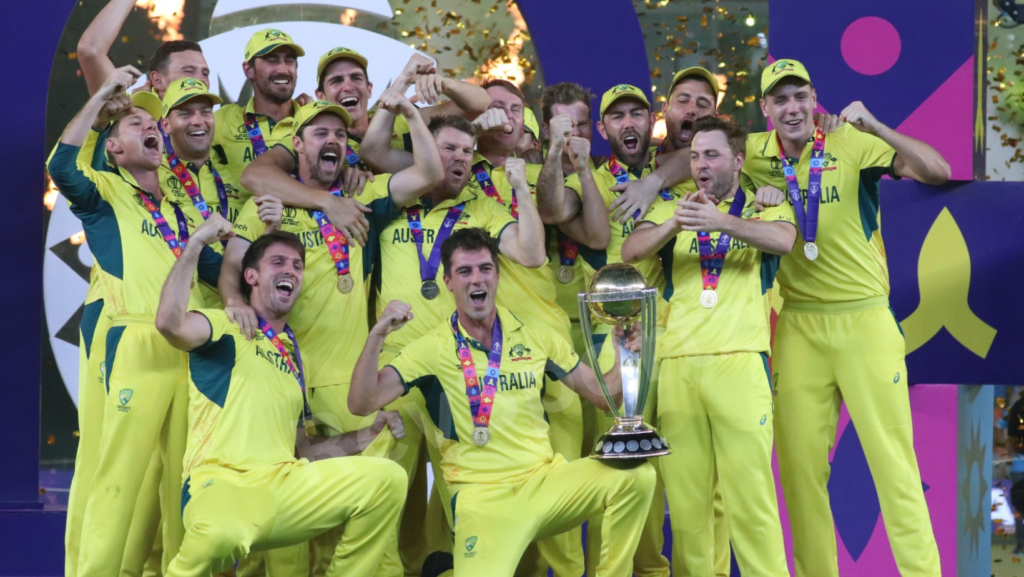
As the dates on the calendar ticked over, from October to November, India’s momentum seemed inexorable. The towelling of South Africa at Eden Gardens was intimidating, reminiscent of Muhammad Ali toying with a succession of highly rated heavyweights in his mid-1960s prime. New Zealand gave it a proper go in the semi-final, but in the end, it was always going to come down to the ultimate test in cricket – a knockout game against Australia.
Other teams have cut a swathe through previous World Cups, just as India did in 2023. But even in those tournaments, Australia found a way to turn it on at just the right time. In 1987, Imran Khan’s Pakistan and Kapil Dev’s Indians were both running hot, and Eden Gardens was all set to host an unforgettable Radcliffe-Line final. But Allan Border’s Australia’s, utterly unfancied, beat India in their opening game in Chennai, and Pakistan in a Lahore semi-final before seeing off England in front of a crowd of 90,000 in Kolkata.
Since that first triumph, Australia’s appetite for the big occasion has been gluttonous. Going back to the first edition in 1975, they have played 20 knockout games, winning 15 of them. That includes seven semi-finals out of nine, and six finals from eight. There’s also the small matter of that Edgbaston tie against South Africa in 1999, when the result took them to the final and a crushing victory against Pakistan.
That tournament was perhaps the best illustration of Australian mental strength. Group stage losses to New Zealand and Pakistan meant that they entered the Super Sixes with zero points and no margin for error. At 48-3, in pursuit of a target of 272 against South Africa at Headingley, Australia looked dead and buried.
But in his eagerness to celebrate, Herschelle Gibbs didn’t hold on long enough at midwicket when Steve Waugh had made 56. Australia’s captain had made just one century in 265 previous ODIs. But his unbeaten 120 saw them home, and into the last four. There, even with South Africa just needing a run from four balls, it was Australia that kept their nerve to secure a tie and a place in the Lord’s final.
This 2023 side came into the tournament an utter mess. No less a person than Michael Clarke, winning captain in 2015, reckoned that Australia didn’t know what their best XI was. Brushed aside by India and thumped by South Africa, Australia were staring at an inglorious group-stage exit for the first time since 1992.
Also Read: India’s Quest for the Missing One Percent Must Drive Rohit Sharma and Team Forward
That was when the experienced core came to the fore. David Warner is 37, but you wouldn’t have known it the way he covered ground to take sensational catches to send back Pathum Nissanka and Kusal Mendis in Lucknow. That Sri Lankan collapse from 125-0 to 209 all out utterly transformed Australia’s campaign. And it was no coincidence that Pat Cummins, the captain, played a massive part with the ball.
When a group of players have known how to win, and often, that comes to the fore at the most crucial moments. Australia were nowhere near as clinical as India in the league phase, but in tense matches against New Zealand, England and Afghanistan, someone or the other would pick up the standard and take the team forward.
There were echoes of the 2015 campaign where New Zealand beat them in the group game at Eden Park, only for Australia to thoroughly dominate the final at the MCG. In Ahmedabad, what was most impressive was how quickly they sussed out the conditions. At the toss, Rohit Sharma spoke of how he would have batted first. In big games, you want the comfort of runs on the board. That’s conventional wisdom.
Australia looked at an abrasive pitch and the results of previous games, and decided to go against that. Once Travis Head took a catch for the ages to send back Rohit Sharma, India were reeled back in like the catch on the end of a fishing line. The pacers bowled cutters into the pitch and the slow bowlers started getting through the overs at Ravindra Jadeja-like speed.
The fielding in the inner circle was like a vice that India could never escape. On the rare occasions when Virat Kohli and KL Rahul managed to breach the cordon, someone would sweep across to cut off the four. India, who had suffocated the opposition with their intensity over ten games, couldn’t find an answer when the blanket was thrown over them.
If the 1987 World Cup win was the start of Australian cricket’s modern golden age, then this ranks right up there as the most impressive of their trophy wins. The 2015 win came on home turf in conditions they knew intimately. In 2003 and 2007, they were by far the best team in the competition. In 1999, despite that false start, there was too much quality in the ranks for them to fail. This time, they seemed to be just one among a pack of three or four teams trailing well behind India. But as Australian teams have done so often in nearly a century and a half of cricket, they turned it on when it mattered most. On the home straight, unfazed by a partisan crowd, they did a Phar Lap, and left India trailing in their wake.
Also Read: “A Brilliant Run without a Fairy-Tale Ending” – Sania Mirza and other Sporting Greats Take Stock



